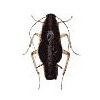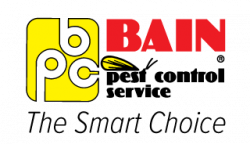Bain technicians are thoroughly trained in cockroach biology and control measures. Treatments may consist of baiting, insecticide dusts, spraying or aerosols depending on the level of infestation. Cockroach control is dependent on good sanitation practices to reduce food, water, and harborage areas. Food debris and grease must be thoroughly removed and sanitized. Excess clutter should be eliminated and cracks/crevices in kitchen, bathroom, or any other area of infestation, should be caulked to help minimize harborage areas.
German Cockroaches

- The most common residential and commercial cockroach in the United States
- The adult German cockroach is 1/2 – 5/8 inch in length, and brown to dark brown in color with two parallel lines running the length of the pronotum
- The German cockroach is omnivorous, eating table scraps, pet food, book bindings, soap, or glue
- The female carries an egg sack which contains 30-40 eggs. The egg sack can be seen protruding from the posterior end of the female
- They forage for food mostly at night. If cockroaches are observed during the day it may indicate a high level of activity
- The saliva, feces and bodies of cockroaches have been known to trigger allergies and asthma in humans.
American Cockroaches

- The American cockroach is second only to the German cockroach in abundance
- Adults are reddish brown, measure 1 1/2 inches in length, and have fully developed wings. Nymphs are similar in appearance but do not possess wings
- They are most common found in dark, moist and warm areas including basements, sewers, steam tunnels, and drainage systems. They may also be found in commercial buildings, restaurants, grocery stores or other buildings where food is prevalent. They are rarely are found in houses
- The females produce an egg sack about once per month for ten months laying 16 eggs per egg case. They may live up to 2 1/2 years
- The American cockroach is omnivorous eating decaying organic matter but since the cockroach is a scavenger it will eat most anything including paper, boots, hair, bread, fruit, book bindings, fish, peanuts, the soft part on the inside of animal hides, cloth and dead insects
